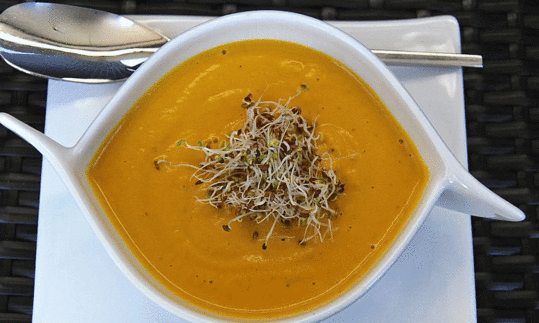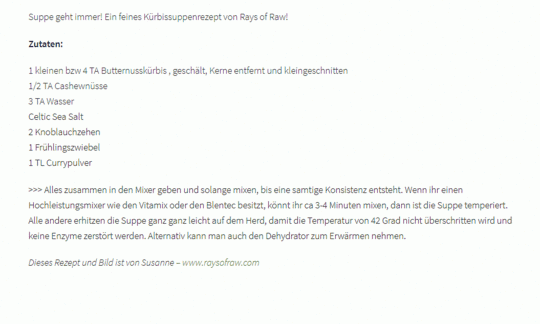curried butternut squash soup with sprouts
vegan
Ingredients (for servings, )
| For the soup | |
|---|---|
| 4 Tassen, gehackt | Butternut squash, raw (pear squash), one butternut squash (20 oz) |
| 2 cloves | Garlic (organic?) (0.21 oz) |
| 1 | Spring onions, stems and leaves only (raw, organic?) (0.87 oz) |
| ½ cup | Cashew nuts, raw? organic? (cashew nuts) (2.3 oz) |
| 600 ml | Drinking water, raw (organic?) (21 oz) |
| 1 dash | Sea salt (raw?, organic?) (0.01 oz) |
| 1 tsp | Curry powder (organic?, raw?) (0.07 oz) |
| As a soup garnish | |
| ½ cup | Garden cress, raw (organic?) (0.88 oz) |
Equipment
- blender
- vegetable peeler
Type of preparation
- chop or grind
- food preparation without heating
- blend
- remove the skin
- peel
Preparation
For the soup
Peel the butternut squash, remove the seeds and cut into cubes.
Peel the garlic. Wash the spring onions and chop roughly.In our original recipe, which serves 3 people, we use one small, or 4 cups, chopped butternut squash.
Put everything together with the remaining ingredients (apart from the cress) in the blender and mix until it reaches a velvety consistency.
If you use a high-performance blender, you can blend for about 3-4 minutes, then the soup will be at the right temperature. Alternatively, heat the soup briefly on the stove, but the temperature should not exceed 42 °C so that the enzymes remain intact. You can also use a dehydrator to heat it up.
serving
Pour the soup into soup bowls and add cress as needed.The original recipe does not specify the amount and type of sprouts.
|
Nutritional Information per person
Convert per 100g
|
2000 kcal | |
|---|---|---|
| Energy | 165 kcal | 8.3% |
| Fat/Lipids | 10 g | 14.6% |
| Saturated Fats | 1.9 g | 9.4% |
| Carbohydrates (inc.dietary fiber) | 16 g | 5.8% |
| Sugars | 7.4 g | 8.2% |
| Fiber | 3.2 g | 12.9% |
| Protein/Albumin | 6.4 g | 12.7% |
| Cooking Salt (Na:61.8 mg) | 157 mg | 6.5% |
| Essential micronutrients with the highest proportions | per person | 2000 kcal | |
|---|---|---|---|
| Vit | Vitamin A, as RAE | 852 µg | 106.0% |
| Vit | Vitamin K | 72 µg | 96.0% |
| Min | Copper, Cu | 0.70 mg | 70.0% |
| Vit | Vitamin C (ascorbic acid) | 44 mg | 55.0% |
| Min | Manganese, Mn | 0.83 mg | 41.0% |
| Elem | Potassium, K | 637 mg | 32.0% |
| Prot | Tryptophan (Trp, W) | 0.08 g | 32.0% |
| Elem | Magnesium, Mg | 109 mg | 29.0% |
| Elem | Phosphorus, P | 202 mg | 29.0% |
| Vit | Vitamin B9, B11 (Folate, as the active form of folic acid) | 50 µg | 25.0% |
Detailed Nutritional Information per Person for this Recipe
The majority of the nutritional information comes from the USDA (US Department of Agriculture). This means that the information for natural products is often incomplete or only given within broader categories, whereas in most cases products made from these have more complete information displayed.
If we take flaxseed, for example, the important essential amino acid ALA (omega-3) is only included in an overarching category whereas for flaxseed oil ALA is listed specifically. In time, we will be able to change this, but it will require a lot of work. An “i” appears behind ingredients that have been adjusted and an explanation appears when you hover over this symbol.
For Erb Muesli, the original calculations resulted in 48 % of the daily requirement of ALA — but with the correction, we see that the muesli actually covers >100 % of the necessary recommendation for the omega-3 fatty acid ALA. Our goal is to eventually be able to compare the nutritional value of our recipes with those that are used in conventional western lifestyles.
| Essential fatty acids | per person | 2000 kcal |
|---|---|---|
| Linoleic acid; LA; 18:2 omega-6 | 1.8 g | 18.0% |
| Alpha-Linolenic acid; ALA; 18:3 omega-3 | 0.10 g | 5.0% |
| Essential amino acids | per person | 2000 kcal |
|---|---|---|
| Tryptophan (Trp, W) | 0.08 g | 32.0% |
| Threonine (Thr, T, irreversibly transaminated) | 0.20 g | 21.0% |
| Isoleucine (Ile, I) | 0.24 g | 20.0% |
| Valin (Val, V) | 0.33 g | 20.0% |
| Leucine (Leu, L) | 0.43 g | 18.0% |
| Phenylalanine (Phe, F) | 0.28 g | 18.0% |
| Lysine (Lys, K, irreversibly transaminated) | 0.31 g | 17.0% |
| Methionine (Met, M) | 0.11 g | 12.0% |
| Vitamins | per person | 2000 kcal |
|---|---|---|
| Vitamin A, as RAE | 852 µg | 106.0% |
| Vitamin K | 72 µg | 96.0% |
| Vitamin C (ascorbic acid) | 44 mg | 55.0% |
| Vitamin B9, B11 (Folate, as the active form of folic acid) | 50 µg | 25.0% |
| Vitamin B6 (pyridoxine) | 0.34 mg | 24.0% |
| Vitamin B1 (Thiamine) | 0.20 mg | 18.0% |
| Vitamin B5 (Pantothenic acid) | 0.54 mg | 9.0% |
| Vitamin B2 (Riboflavin) | 0.12 mg | 8.0% |
| Vitamin B3 (Niacin) | 1.2 mg | 8.0% |
| Vitamin E, as a-TEs | 0.68 mg | 6.0% |
| Vitamin B7 (Biotin, ex vitamin H) | 2.5 µg | 5.0% |
| Essential macroelements (macronutrients) | per person | 2000 kcal |
|---|---|---|
| Potassium, K | 637 mg | 32.0% |
| Magnesium, Mg | 109 mg | 29.0% |
| Phosphorus, P | 202 mg | 29.0% |
| Calcium, Ca | 71 mg | 9.0% |
| Sodium, Na | 62 mg | 8.0% |
| Essential trace elements (micronutrients) | per person | 2000 kcal |
|---|---|---|
| Copper, Cu | 0.70 mg | 70.0% |
| Manganese, Mn | 0.83 mg | 41.0% |
| Zinc, Zn | 1.9 mg | 19.0% |
| Iron, Fe | 2.6 mg | 18.0% |
| Selenium, Se | 5.4 µg | 10.0% |
| Fluorine, F | 144 µg | 4.0% |
| Iod, I (Jod, J) | 1.3 µg | 1.0% |
The curry butternut squash soup with sprouts is quick to prepare and doesn't require cooking, but because of the cashews it is not strictly raw food.
Portions: The original recipe does not specify portions. We have designed the recipe as a main course for 3 people. It can also be served as a starter or side dish.
Nutrient profile: According to GDA guidelines, one portion of this recipe covers more than the average daily requirement of vitamin A and over ¾ of that of vitamin K. Copper and vitamin C are covered by over 50%. The ratio of omega-6 to omega-3 fatty acids, at 26:1, significantly exceeds the recommended maximum ratio of 5:1. By clicking on the link above the recipe picture, or under "Alternative preparation", you will be taken to a health-optimized subsidiary recipe.
Butternut squash: The butternut squash has a comparatively thin skin and a high proportion of tender, light orange flesh, which has a buttery, slightly nutty aroma. The pumpkin has a high content of beta-carotene, which is good for skin, hair and eyesight. 100g of butternut squash covers around 80% of the daily requirement of beta-carotene.
Cashew kernels (or cashew nuts): Cashew kernels, also called cashew nuts or simply cashews, are a good source of minerals such as magnesium and iron. They have a mild and slightly sweet taste. Cashew kernels are inedible raw because they contain the toxic oil cardol. Cashew nuts sold in stores are therefore either pre-treated with steam or roasted to deactivate the cardol. They are therefore not raw in the true sense of the word. If it says "raw cashew kernels" on the package, this usually only indicates that the toxic cardol was deactivated using steam rather than a roasting process. We can only assume that the food is raw if the process is explained in detail and checked. We have therefore declared this recipe as cooked food.
Garden cress: Garden cress belongs to the cruciferous family. Its characteristic, sharp taste, somewhat reminiscent of mustard, is due to benzyl isothiocyanate. In cooking, the main plant used is the cress seedlings, which can be harvested about a week after sowing. Garden cress is ideal for cold spreads and salads, or for soups, as is the case in this recipe. Because garden cress contains a lot of vitamin C, iron, calcium, folic acid and vitamin B, it is a good nutritional supplement, especially in winter.
Sow garden cress yourself: Garden cress can be grown all year round. The seeds required for this can be purchased in garden centers and large supermarkets. Then simply sow the cress seeds in soil or even just on damp cotton wool and place them on the windowsill. It likes it warm and needs a lot of water.
Health: For health reasons, we have created an alternative recipe with variations in the ingredients. Please read the link behind this motivation: Vegans often eat unhealthily. Avoidable nutritional errors .





